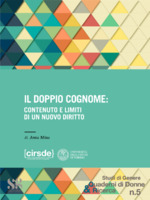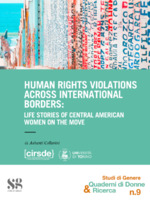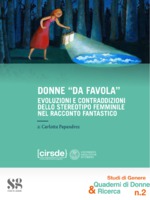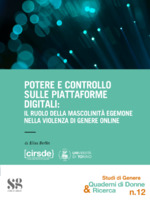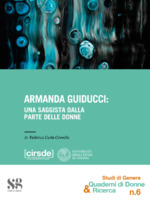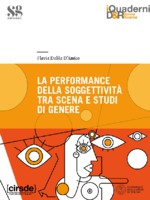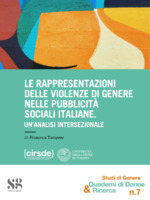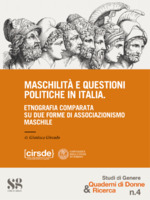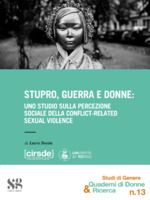Sfoglia documenti (13 in totale)
- Collezione: Studi di Genere. Quaderni di Donne & Ricerca
Sort by:
Il doppio cognome: contenuto e limiti di un nuovo diritto
The work aims to analyze the current legislation on the transmission of the surname to the children in the Italian legal system, to verify if this rule respects the principle of equality between the parents and the principle of the protection of the child's personal identity.
The rule of automatic transmission of the father's surname was indeed a glaring symbol of discrimination between parents, which reflected a deep-rooted background of inequality between men and women that can still be seen today.
The decision of the Corte Costituzionale n. 286/2016 stated that parents can give their child the surname of the father, followed by the surname of the mother if both are in agreement. Nevertheless, there are issues that a jurisprudential decision, even if crucial for the matter, cannot resolve. In fact, the judgment doesn't solve the question of the accumulation of surnames in future generations, and doesn't decide whether the children of the same family should have the same surname.
After a careful analysis of the issues that currently remained unresolved, hypotheses will be formulated to find solutions that are both respectful of the right of equality between parents and of the personal right of the child to have both branches of his family recognized in his surname. Lastly, the answers obtained from the interviews regarding the matter of the "double surname", in which several Italian municipalities participated, will be examined and will be subject to reflection.
Human rights violations across international borders: life stories of Central American women on the move
The essay documents and analyses the topic of violence in Central American migration, with a specific focus on migrant women in the current mobility regime South-North. We start by tracing the conditions that push women to undertake the migratory path in their countries of origin, more specifically in the Northern Triangle countries, that include Honduras, El Salvador and Guatemala; we then analyze the moment of transit, in order to highlight some of the great challenges that women incur in their path towards the destination country, being it Mexico or the United States; lastly, we shed light on the border-crossing experience and on some life stories in the context of arrival. Through this work we aim at demonstrating that the journey of Central American women is shaped by different forms of violence in every step of migration, and how the mobility and border regime is strongly compromised by the lack of application of a human rights approach. The personal contribution to this work is given by a fieldwork realized through eight qualitative interviews with experts in the field.
Donne "da favola". Evoluzioni e contraddizioni dello stereotipo femminile nel racconto fantastico
How has the image of the woman changed over time? Can we say that certain "old" stereotypes have lapsed?
In this analysis I’ve reflected about the theme, comparing some modern cinematographic revisitations and the corresponding written texts in the field of the fantastic genre, to understand if and how the female image (and not only) has changed from a century to another (in this case between the 19th and the 21st century).
The research has developed through the semiotic and gender studies, in order to analyze the diversities and the characteristics of the various texts observed (written and audiovisual) and to realize how the idea of feminine is changed and, maybe, evolved, proposing new type of characters (and also a new and complex dialogue with the masculine counterpart).
It emerges, indeed, the necessity to reflect on these stereotypes, on the modalities of development over time and on the difficulty that still today, despite certain changes, remains in thinking them (and thinking differently).
Because, in the end, what does it mean male and female? What makes us who we are?
Prostituzione e diritti fondamentali: un'analisi comparata delle costituzioni e delle legislazioni nazionali
Lo scritto analizza i modelli legislativi esistenti in materia di prostituzione sul panorama europeo, soffermandosi su quei delicati profili giuridici inerenti il bilanciamento dei diritti fondamentali racchiusi nelle singole Costituzioni nazionali. In particolare l'analisi riguarda l'ordinamento russo, svedese, italiano e tedesco, che rispettivamente riflettono il proibizionismo, il neoproibizionismo, l'abolizionismo e la regolamentazione della prostituzione.
The work deals with the existing relationship between prostitute's fundamental rights and all the legal frameworks which are in force in Europe.
Chapter I examines some legal, thorny issues concerning prostitution, such as the disposal of the body, the notion of human dignity, the equality principle, the general clause of good customs, the right to work and to health and. In Chapters II-V these issues are transposed into the analysis of four European States' Constitution and legislations.
The Russian prohibitionism is characterised by the prostitutes' administrative prosecution on the basis of public morality and health.
The Swedish neo-prohibitionism aims at establishing a gender policy, which is grounded on a new social order; as a result, Swedish law subjects clients to sanctions, while considering prostitutes as victims who deserve a special protection.
Italian abolitionism provides for a freedom to prostitute yourself which must be in compliance with the general clause of public morality, while prosecuting all those activities that are ancillary and apt to violate the prostitutes' self-determination; in any case, the legislative aim is to respect and fulfil all the constitutional fundamental rights.
The German regulatory framework regards prostitution as an expression of the occupational freedom provided by the Basic Law, in order to promote the individual's substantial self-determination and to protect prostitutes' fundamental rights.
Finally the work ends with a short consideration on whether there is - or there is not - a legal pattern which is apt to protect all the fundamental rights to whom prostitutes are entitled.
Potere e controllo sulle piattaforme digitali: il ruolo della mascolinità egemone nella violenza di genere online
This essay aims to investigate, through an analysis of the literature and the presentation of an experimental study, the main psycho-social risk factors underlying online gender-based violence, together with the way in which this form of abuse is perceived by the population.
The first chapter offers an overview of the main psychological, emotional and relational dynamics underlying gender-based discrimination and abuse (online or offline), together with the analysis of some behavioural practices frequently carried out in the context of the so-called “homosocial relationships” (Bird, 1996).
The second chapter of this work specifically addresses the presentation of the aforementioned environments. In this regard, the illicit production of sexually explicit material, the use of photo-editing techniques within a pornographic frame (deepfake-porn) and the submission of one's own genitals' photos without the recipient's consent (cyberflashing) represent some of the online gender-based form of abuse most frequently carried out, together with the non-consensual dissemination of intimate images. The last part of the second chapter presents the so-called “manosphere”, a virtual network made up of blogs, forums and online groups explicitly dedicated to the establishment of homosocial relationships based on nostalgia for the traditional patriarchal values.
The third chapter addresses the prevention of online gender-based violence. Since the introjection of sexist beliefs and gender stereotypes begins in early childhood, offering young people non-stereotyped grafic, linguistic and media representations is crucial, as well as addressing topics such as gender, affectivity and non-judgmental sexuality in primary and secondary school. On the other hand, an equally important role belongs to the media system, due to its ability to promote social norms introjection by the population (Cialdini and Trost, 1998).
Finally, the fourth chapter offers a brief presentation of this experimental research project. The study highlighted a strong relationship between individual levels of sexism, sexual double standard and right wing authoritarianism and, on the other side, people's ability (or inability) to feel empathy towards victims of online gender-based violence, emphasazing the need to address these variables in order to prevent the diffusion of the phenomenon.
Armanda Guiducci: una saggista dalla parte delle donne
The work outlines the profile of Armanda Guiducci (Naples 1923 - Milan1992): philosopher, anthropologist, writer and literary critic. Through various archive researches the author's literary biography has been reconstructed, which returns the image of an eclectic writer, with composite intellectual activity and a wide and varied production. At the same time the work studies seven essays by Guiducci on the condition of women which, although they share a purely anthropological approach, belong to different genres. Therefore, underlining analogies and differences, the thesis highlights how each of them declines certain themes, as the point of view assumed by the author and the use of some common stylistic traits; with the aim of providing an even more detailed profile.
La performance della soggettività tra scena e studi di genere
My research focuses on the relation between the body and the subject in the field of performing arts (i.e. Dance and theatre). The goal of the research is on the one hand, to disclose how contemporary art practices rethink subjectivity by processing, comparing, and deconstructing its social images. On the other hand, to question the current methodological approach of the performing art theories.
Despite the Identity Studies (Disability Studies, Feminist Studies, Queer Studies ecc) and the artistic practices are questioning the categories of body, subject, genre and race, the theatrical scholars, at least in Europe, are far from the adoption of methodological and linguistic instruments suitable for the interpretation of the artistic and philosophical contemporary scenario.
The reformulation of the theatrical form took place trough decomposition of the whole of a genre into its individual elements. Text, body, lights, object, sounds are each treated as autonomous realities. Once the actor is free from the playing a character, the representation of the subject is entrusted to the body. Consequently, theatrical scholars, from different perspectives, have considered reduced the actor's ability to attest a subject. The main hypothesis of this research is that artistic practices go beyond both stereotypes and available scientific theories, creating further lens for the reading of subjectivity. At the same time these experiences put into question the adoption of uniform and stable categories for the interpretation of the actor's work.
Le rappresentazioni delle violenze di genere nelle pubblicità sociali italiane. Un’analisi intersezionale
According to the literature (Oddone 2013; Ciccone 2014; Cosenza 2015; Magaraggia 2015; Polizzi & Oliveri 2015), the representations of gender-based violence in Italian social advertisements are strongly linked to stereotypical imaginaries of the physical dimension, domestic violence, and the removal of victims' agency, as well as heteronormative and ableist ones. In my qualitative research on 12 advertisements (from 2006 to 2019), I tried to identify representations that go beyond hegemonic terms, with particular attention to the dimensions of racism, ableism and homolesbobitransphobia, applying the intersectional approach, to reacha more complex understanding of how identities and power relations are constructed in visual media. My analysis sought to answer the question of whether social advertisements contain images that challenge stereotypes and prejudices regarding violences, or whether they reiterate certain representational mechanisms that are the result of the phenomenon they are intended to combat. The hypotheses on their verifiability ‒ and therefore on the scarce capacity to challenge the preconceptions of those advertisements that by their function should promote social change ‒ were tested on the basis of the following variables, according to a qualitative methodology that refers to socio-semiotic visual analysis in search of counter-hegemonic narratives: promoting subjects, ways of representing the places of violence, representation of the violences themselves, identities and bodies and communicative style. My research shows that, in Italy, it is difficult to carry out campaigns against gender violence that exclude or question stereotypes. On the one hand, there is a gap between innovative aims and the use of stereotypical language, which is typical of social advertising’s form. On the other hand, there are considerable differences between the various promoters: there is a tension between the different structures and aims of the promoters surveyed, between public service advertising and advocacy.
Maschilità e questioni politiche in Italia. Etnografia comparata su due forme di associazionismo maschile
This thesis displays an ethnographic research aimed at the exploration of the «politics of masculinity», which represent a phenomenon of «mobilizations and struggles where the meaning of masculine gender is at issue, and, with it, men’s position in gender relations» (Connell, 1996, 205). Given the shortage of academic and public debate, which historically concerns the themes of masculinity, the research focuses on the concept of crisis and its spread. In addition to its contribution to the growth of media interest and to the development of men’s studies in recent years, this notion has fostered the diffusion of the male voice in the shape of specific associations. This thesis takes into account two Italian experiences that are significant for their theoretical contrast about men’s studies. Bounded up with the social constructionism, Maschile in gioco (Rome) is a group that practises self-consciousness and belongs to the network of Maschile Plurale association, whereas Campo maschile (Brescia) is configured as a project in continuity with the Maschi Selvatici association and with its typically «essentialist» positions. From a methodological point of view, the participant observation – a functional technique for the investigation of form and content of the two case studies – is accompanied by the technique of «focused interview». These qualitative techniques are useful for studying experiences of which literature has already highlighted the contrast in terms of discursive repertoires: in the first case they are aimed at the deconstruction of masculinity, in the second at its reconstruction. However, by enhancing the «continuity» between content and form, the research lays particular stress on a common – even though oriented towards opposite directions – work, which involves the two case studies as all-male socialization agencies. In the end, the research emphasizes the recurrence of a model of masculinity close to intimacy – not far from the concept of «caring masculinities» (Elliott, 2015) – which unites the two case studies and is able, perhaps, to challenge the deep-rooted patriarchal system of our society.
Stupro, guerra e donne: uno studio sulla percezione sociale della conflict-related sexual violence
War has been, and still is, highly characterized by sexual violence. The present work takes a cue from the testimonies of victims of Conflict-Related Sexual Violence narrated by Lamb (2020) in “Our Bodies, Their Battlefield: What war does to Women” since, as the author writes, “You won’t find these women’s names in the history books or on the war memorials that we pass in our railway stations and town centres but to me, they are the real heroes.” (p.11).
Although war rape has existed for as long as conflicts themselves have existed, the legislative relevance of this crime as a crime against humanity, as a weapon of genocide, and as a war crime, only came into existence following the establishment of ad hoc international criminal tribunals for the former Yugoslavia and Rwanda.
Understanding the origin of sexual violence in armed conflicts is very complex as it is the result of multiple variables: from cultural norms to complex political and war strategies. Rape is often committed to terrorizing the population, breaking up families, destroying communities and even changing the ethnic composition of the next generations.
Many studies have focused on the socio-political analysis of this reality and the consequences at individual, social, and community levels. Few, however, have investigated the social perception of this issue. The main purpose of this exploratory research is to investigate whether people's perception of sexual violence can be influenced and modified by the war context in which this violence occurs, since, as Frese and colleagues (2004) point out, the characteristics of the context in which the violence occurred influence the participant’s perception of the event. In particular, the focus was on the recognition of the event as violence, the perception of severity, and the punitiveness of the perpetrators.

